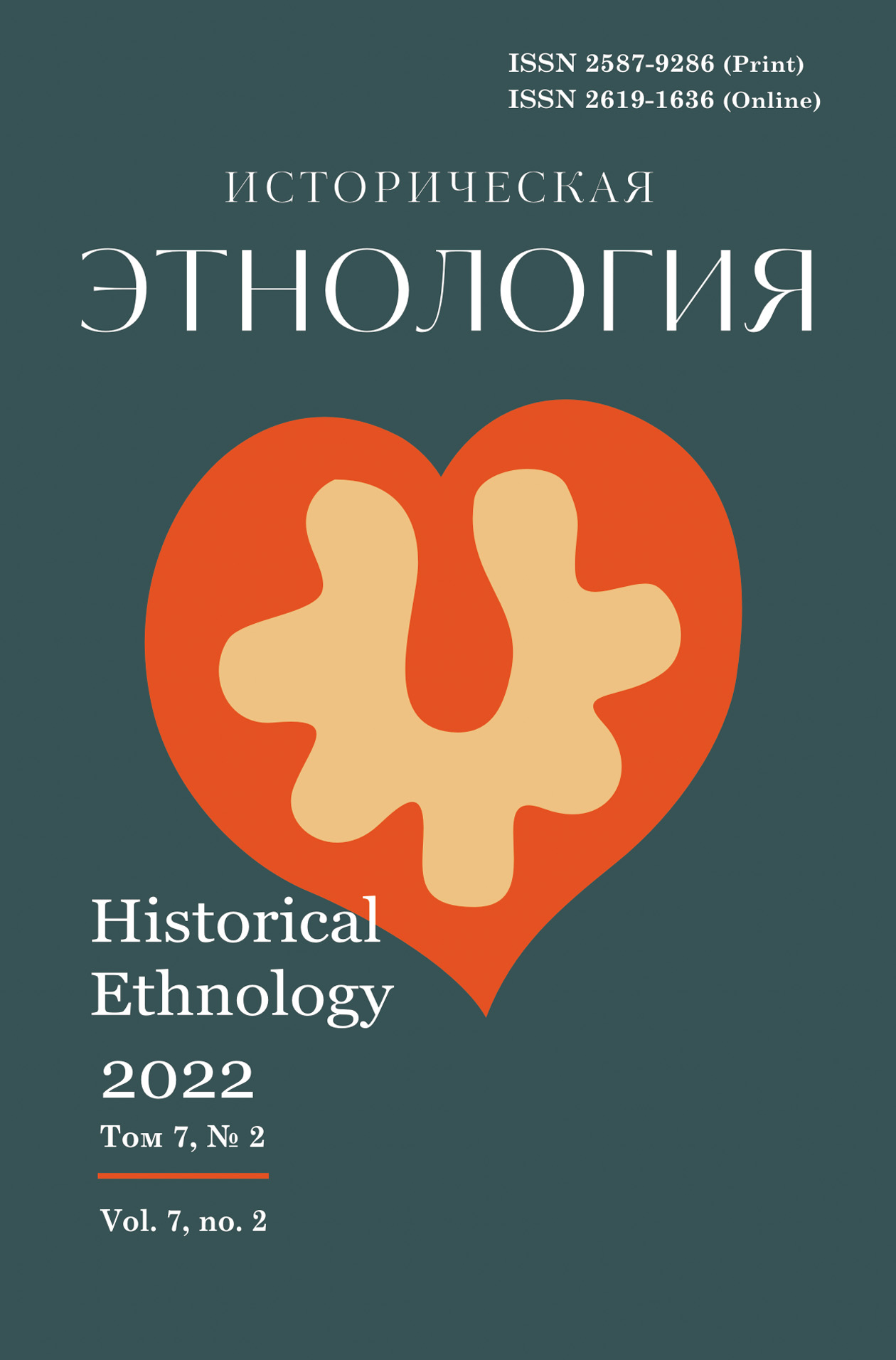About two Central Asian pendants from the collections of Peter the Great Museum of Anthropology and Ethnography of the Russian Academy of Sciences: experience of ethnological and technological expertise
Suslova S.V., Donina L.N.
254-273 p.
doi.org: 10.22378/he.2022-7-2.254-273
An expert historical, ethnological and technological analysis of two Central Asian jewelry pendants from the collections of Peter the Great Museum of Anthropology and Ethnography (the Kunstkamera) of the Russian Academy of Sciences (MAE RAS) (2014 exposition) allows us to consider them as variations of the traditional chulpa-type jewelry of the Volga-Ural Tatars. They are pendants for braids made of plaques and silver coins collected in various compositions. The genesis of the chulpa structurally and functionally connected with the traditions of the Finno-Ugric population of the Volga Bulgaria. Chulpas were also widely used for decorating other types of braid jewelry – cloth types of Tatar braids, formed in line with other, Turkic-nomadic traditions of Eurasia. A filigree pendant made of blade-shaped plaques from the MAE RAS funds is a vivid example of the ethno-cultural and artistic traditions of the Volga-Ural Tatars. This is confirmed by the plaque manufacturing technology which fully corresponds to the craft traditions of the Kazan-Tatar jewelry school. Another pendant with tulip-shaped plate plaques at the base was obviously made by the Tatar artisans as well, taking into account a number of local Central Asian (Kazakh) jewelry traditions. The translation of ethno-specific Tatar jewelry into the traditional culture of the Turkic-Muslim peoples of Eurasia, including Central Asian ones, was carried out thanks to the functioning of the “secondary” Kazan-Tatar centres of jewelry production in the east of the Volga-Ural region. This was especially facilitated by the production and trading activities of the well-known in Russia Rybnaya-Sloboda handicraft industry. The analysis based on typological, cartographic and illustrative materials of the Historical and ethnographic atlas of the Tatar people (volume “Folk costume”).
Keywords: braid decorations, jewelry traditions, Tatars, Volga Bulgars, Turkic nomads
For citation: Suslova S.V., Donina L.N. O dvukh tsentral’noaziatskikh podveskakh iz fondov Muzeya antropologii i etnografii imeni Petra Velikogo Rossiyskoy akademii nauk: opyt etnologo-tekhnologicheskoy ekspertizy [About two Central Asian pendants from the collections of Peter the Great Museum of Anthropology and Ethnography of the Russian Academy of Sciences: experience of ethnological and technological expertise]. Istoricheskaya etnologiya, 2022, vol. 7, no. 2, pp. 254–273. https://doi.org/10.22378/he.2022-7-2.254-273 (In Russian)
REFERENCES
Belavin A.M. O svoeobrazii yuvelirnoy produktsii Volzhskoy Bulgarii 10–13 vv. [On the Originality of the Jewelry Production of the Volga Bulgaria in the 10th – 13th Centuries]. Aktual’nye problemy istoricheskoy nauki [Actual Problems of the Historical Science]. Perm, 1989. (In Russian)
Donina L.N., Suslova S.V. Kazansko-tatarskoe yuvelirnoe iskusstvo v kontekste tekhnologicheskikh traditsiy khudozhestvennogo metalla Evrazii [Kazan-Tatar Jewelry Art in the Context of the Technological Traditions of the Artistic Metal of Eurasia]. Yuvelirnye ukrasheniya tyurkskikh narodov Evrazii [Jewelery of the Turkic peoples of Eurasia]. Kazan: Sh. Marjani Institute of History of the Tatarstan Academy of Sciences Publ., 2018, pp. 199–224. (In Russian)
Donina L.N., Suslova S.V. O zolotoordynskikh traditsiyakh v yuvelirnom iskusstve kazanskikh tatar: na primere filigrannykh mindalevidnykh seryog [On the Golden Horde Traditions in the Jewelry Art of the Kazan Tatars: On the example of filigree almond-shaped earrings]. Zolotoordynskoe obozrenie [The Golden Horde Review). 2019, vol. 7, no. 3, pp. 461–484. (In Russian)
Gadzhieva S.Sh. Material’naya kul’tura nogaytsev v 19 – nachalo 20 vv. [The Material Culture of the Nogais in the 19th – early 20th centuries]. Moscow: Nauka Publ., 1976. (In Russian)
Khalikova E.A. Rannevengerskie pamyatniki Nizhnego Prikam’ch i Priural’ya [Early Hungarian Monuments of the Lower Kamch and the Urals]. Sovetskaya arkheologiya [Soviet Archeology]. Moscow: Nauka Publ., 1976, no. 3, pp.141–156. (In Russian)
Kramarovskiy M.G. K istokam kazanskoy skani [To the Origins of Kazan Filigree]. Srednevekovaya Kazan’: vozniknovenie i razvitie [Medieval Kazan: Emergence and Development]. Ed. by F.Sh. Huzin. Kazan: Master-Layn Publ., 2000, pp. 272–278. (In Russian)
Krylasova N.B. Istoriya Prikamskogo kostyuma: kostyum srednevekovogo naseleniya Permskogo Predural’ya [The History of the Kama Costume: the Costume of the Medieval Population of the Perm Cis-Urals]. Perm, 2001, 259 p. (In Russian)
Kul’tura Bilyara [The Culture of Bilyar]. Moscow: Nauka Publ., 1985. (In Russian)
Mikhaylova E.A. S”emnye ukrasheniya narodov Sibiri [Removable Ornaments of the Peoples of Siberia]. Ukrasheniya narodov Sibiri [Ornaments of the Peoples of Siberia]. St. Petersburg: MAE RAN Publ., 2005, vol. 51, pp. 12–120. (In Russian)
Molotova T.L. Mariyskiy kostyum [The Mari Costume]. Cheboksary: Perfektum Publ., 2020. (In Russian)
Pletnyova S.A. Pechenegi, torki i polovtsy v yuzhnorusskikh stepyakh [Torks and Cumans in the South Russian Steppes]. Trudy Volgo-Donskoy arkheologicheskoy ekspeditsii [Proceedings of the Volga-Don Archaeological Expedition]. Moscow-Leningrad, 1958, vol. 1, MIA, no. 62, pp. 151–226. (In Russian)
Shitova S.N. Bashkirskaya narodnaya odezhda [Bashkir Folk Clothes]. Ufa: Kitap Publ., 1995. (In Russian)
Suslova S.V. Tatarskiy kostyum. Istoriko-etnologicheskoe issledovanie [Tatar Costume. Historical and Ethnological Research]. Kazan: Tatarskoe knizhnoe izdatel’stvo Publ., 2018. (In Russian)
Suslova S.V., Mukhamedova R.G. Narodnyy kostyum tatar Povolzh’ya i Priural’ya: seredina 19 – nachalo 20 vv. Istoriko-etnograficheskiy atlas tatarskogo naroda [Folk Costume of the Tatars of the Volga and Ural regions: mid 19th – early 20th centuries. Historical and Ethnographic Atlas of the Tatar People]. Kazan: Fen Publ., 2000. (In Russian)
Suslova S.V. Kostyum astrakhanskikh tatar: po materialam muzeynykh kollektsiy [Costume of the Astrakhan Tatars: Based on Museum Collections]. Astrahanskie tatary [The Astrakhan Tatars]. Kazan, 1992, pp. 80–89. (In Russian)
Tokhtabaeva Sh.Zh. Shedevry Velikoy stepi [Masterpieces of the Great Steppe]. Almaty: Dayk-Press Publ., 2008. (In Russian)
Trofimova M.I. Rybnaya Sloboda. Zhivye golosa [Rybnaya Sloboda. Live Voices]. Kazan: Idel-Press Publ., 2006. (In Russian)
Usmanova E.R., Logvin V.N. Zhenskie nakosnye ukrasheniya Kazakhstana. Epokha bronzy [Women’s Braided Jewelry of Kazakhstan. The Bronze Age]. Lisakovsk, 1998. (In Russian)
Vorob’yev N.I. Kazanskie tatary: etnograficheskoe issledovanie material’noy kul’tury dooktyabr’skogo perioda [Kazan Tatars (an ethnographic study of the material culture of the pre-October period]. Kazan: Tatgosizdat Publ., 1953. (In Russian)
Vorob’yev N.I., Busygin E.P. Khudozhestvennye promysly Tatarii v proshlom i nastoyashchem [Artistic Crafts of Tataria in the Past and Present]. Kazan: Gosmuzey Tatarskoy ASSR Publ., 1957. (In Russian)
Yagafova E.A. Samarskie chuvashi: istoriko-etnograficheskie ocherki: кonets 17 – nachalo 20 vv. [Samara Chuvash (historical and ethnographic essays: late 17th – early 20th centuries]. Samara: Povolzh’ye Publ., 1998. (In Russian)
About the authors: Svetlana V. Suslova, Cand. Sc. (History), Leading Research Fellow of the Department for Ethnological Research, Marjani Institute of History of the Tatarstan Academy of Sciences (7А, Baturin St., Kazan 420111, Russian Federation); e-mail: sv_suslova@mail.ru
Larisa N. Donina, Cand. Sc. (Art History), Senior Research Fellow of the Department for Ethnological Research, Marjani Institute of History of the Tatarstan Academy of Sciences (7А, Baturin St., Kazan 420111, Russian Federation); lis.art@mail.ru
Received April 1, 2022 Accepted for publication May 31, 2022
Published Online November 23, 2022
|
|








